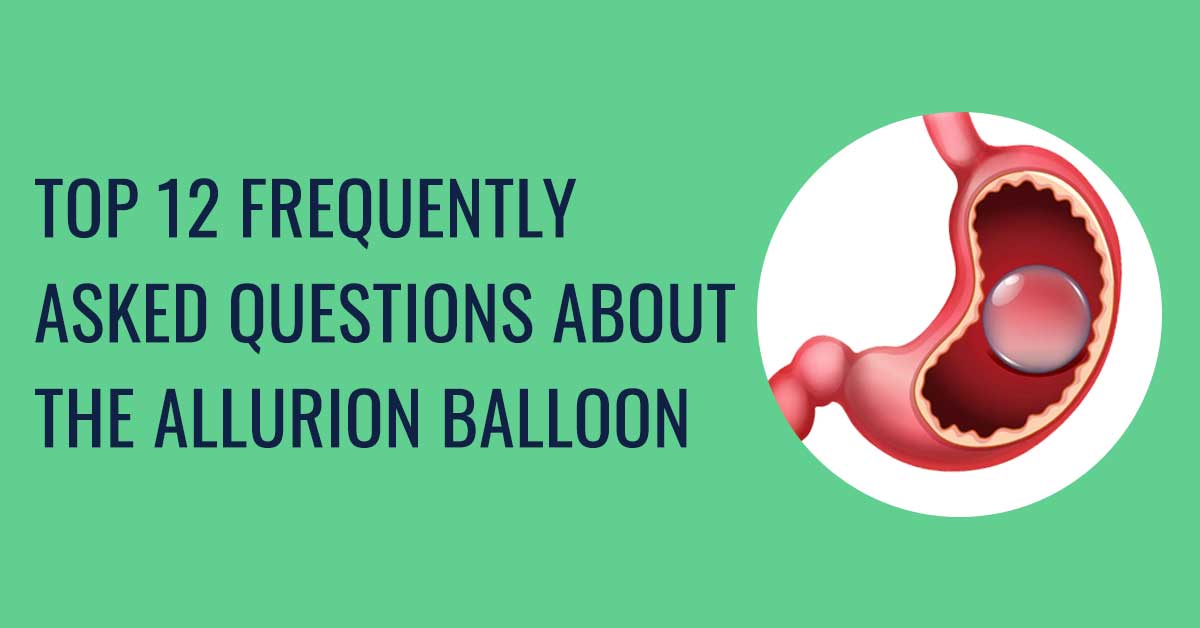Over the last few decades, morbid obesity has become one of the world’s biggest health crises. Studies show that globally, over half a billion people suffer from morbid obesity. For individuals suffering from morbid obesity and its associated comorbidities, losing weight through traditional methods or strict lifestyle changes can be a daunting task. Due to this reason, bariatric surgeries and therapies have been playing a major role in weight management over the last few decades. However, bariatric therapies such as the use of intragastric balloons are becoming an increasingly popular option due to their minimally invasive nature. Furthermore, they seem to produce greater results in weight loss compared to strict diets and exercise routines.
In this article, we will take a look at two of the most popular intragastric balloons (IGBs) on the market, the Orbera and the Allurion IGBs, and compare their major differences.
What are intragastric balloons?
Currently, intragastric balloons are some of the best options for combatting morbid obesity. Compared to pharmacological and surgical treatment options, IGBs are more effective and pose fewer risks. IGB procedures do not require surgery and are carried out endoscopically. Therefore, they are collectively known as endoscopic bariatric therapies, or EBTs. Studies have shown that the results of IGBs can range between 14% and 60% of excess weight loss within the first year of treatment.
IGBs are inflatable balloons that are orally placed within the patient’s stomach with the aid of an endoscope. They utilise a space-occupying mechanism to produce results. An inflated IGB reduces the gastric volume of the patient. As a result, it reduces the amount of food that can be consumed in a single meal. IGBs also produce a prolonged sensation of fullness in the stomach and also delay gastric emptying. When combined, these effects allow patients to considerably cut down on their food intake, making it possible for them to achieve a significant weight loss.
Orbera vs Allurion
Developed over 20 years ago, the Orbera intragastric balloon by Apollo Endosurgery, Inc. is one of the oldest IGBs that is still in use. With more than 300,000 balloons distributed worldwide and a vast amount of data available on its efficacy, this FDA and CE-approved IGB is one of the most commonly used bariatric therapies in the world. It is a temporary procedure and does not require surgery.
Meanwhile, the Allurion intragastric balloon, developed by Allurion Technologies, has been a game changer among bariatric therapies. As the world’s first swallowable IGB, not only does it not require surgery, but it also eliminates the need for endoscopic placement and anaesthesia. It has become increasingly popular due to its comparatively low invasiveness. Allurion Technologies claims to have treated over 100,000 patients worldwide who have collectively shed over a million kilograms of weight with the help of their CE-approved balloon.
The Orbera IGB is a soft, elastic sphere made of silicone. Upon inflation, it reaches about 13 cm in diameter. It comes compressed, commercially. The balloon has a radio-opque self-sealing valve to which a catheter is attached.
The Allurion IGB is quite similar in shape and size to the Orbera. However, the balloon is made from a thin film of flexible polymer known as polyeurethane. This makes the Allurion balloon 85% lighter than silicone balloons such as the Orbera. It also makes the Allurion balloon more flexible than silicone balloons, resulting in a more comfortable experience for the patient. A catheter is attached to the balloon via a degradable, self-sealing valve, which is used to inflate the balloon. The ballon is encased within a gelatinous capsule, which is suitable for vegans as well.
Orbera vs Allurion: Procedure
The implantation procedure is extremely simple with both the Orbera and Allurion balloons.
The Orbera balloon procedure is entirely carried out under endoscopic supervision. After a preliminary diagnostic endoscopy, the patient is sedated and the compressed Orbera balloon is inserted orally into the gastric fundus. This is done with the use of an endoscope. Once the balloon is in place, it is filled, via the catheter, with 500-700 ml of a saline solution. Once the balloon is fully inflated, and the catheter is released, allowing the valve to seal itself. The catheter is then pulled out through the mouth of the patient. The balloon is left floating freely in the patient’s stomach. The entire procedure takes around 20 minutes. After the procedure, the patient is monitored for a few hours to ascertain that they are awake and can swallow before they can leave.
The Allurion balloon, on the other hand, does not require sedation or endoscopy. The balloon comes encased within a gelatinous, vegan capsule which the patient swallows under the guidance of a physician. Most people find the capsule easy to swallow with the aid of some water. For those who find it hard to swallow the pill, a thin stylet is inserted into the catheter to stiffen it and is used to gently guide the capsule beyond the back of the throat. Proper positioning of the balloon within the stomach is monitored via X-ray visualisation. The balloon is then filled with 550 ml of distilled water with a potassium sorbate preservative, and the catheter is pulled back, allowing the balloon to seal itself. A final X-ray is taken to confirm the correct placement of the inflated balloon. The entire procedure can be performed during an outpatient (clinic) visit and takes only about 15 minutes.
Orbera vs Allurion: Mechanism
Both the Orbera and Allurion balloons produce results using similar mechanisms. By occupying roughly 60% of the patient’s gastric volume, both balloons restrict the space within the stomach. Consequently, the amount of food that can be accommodated within the stomach is reduced. The balloon also delays gastric emptying and creates a prolonged sensation of fullness within the stomach. As a result, the patient’s hunger and the amount of food that can be consumed in one sitting are significantly reduced.
Orbera vs Allurion: Extraction
The Orbera balloon is non-surgically extracted from the body 6 months after its implantation. Patients have to avoid solid foods for 72 hours and liquids for 12 hours before the extraction. The extraction is carried out endoscopically, and patients will be sedated before the procedure. An endoscopic tool is used to puncture and deflate the balloon and aspirate the saline solution within. The deflated balloon is then extracted orally. Patients are allowed to go home the same day after being subjected to a few hours of monitoring.
The Allurion balloon extraction is procedureless. It does not require surgery, sedation, or endoscopy. The balloon stays in the stomach for approximately 16 weeks, during which time the filaments of the balloon’s valve degrade. After 16 weeks, the valve fully degrades, deflating the balloon and emptying its contents into the stomach. The remaining polymer film of the balloon is excreted naturally from the body.
Orbera vs Allurion: Side effects
Common, immediate side effects of both the Orbera and Allurion balloons include nausea, vomiting, and abdominal pains. However, these are easily mitigated by medications prescribed by the physician.
The most common severe side effects of both these balloons include intolerance and premature deflation. In both cases, early removal through surgical intervention might be required.
Studies have shown that the early removal rate for the Orbera is about 7%, while the early removal rate for the Allurion is about 2.6%. Some reviews have shown that less than 2% of patients report severe side effects from the Allurion balloon.
Orbera vs Allurion: Results
Both the Orbera and Allurion Balloon seem to produce similar results, with total weight loss (TWL) ranging between 10% and 16%.
According to a study done by the ASGE, the Orbera balloon leads to a total weight loss averaging 13.16% at 6 months and an excess weight loss (EWL) of 26.9%.
A similar study has shown that at 4 months, the Allurion balloon led to a total weight loss of 14.2% and an excess weight loss of 26%. Additionally, 95% of the weight loss is sustained throughout the first year after the balloon has passed out of the body.
Both the Orbera and Allurion balloons significantly reduce the risk of comorbidities associated with morbid obesity, such as type 2 diabetes, heart disease, and non-alcoholic fatty liver.
Orbera vs Allurion: Results
The Orbera balloon program requires candidates to commit to a 12-month program. Patients will have the balloon implanted in their stomachs for 6 months, during which time they will be instructed on a healthy diet and exercise regimen. This is followed by 6 more months of healthy dietary and exercise routines provided by your doctor after the extraction of the balloon.
The Allurion program is a 6-month program in which the Allurion balloon implant will be in the patient’s stomach for 16 weeks (4 months). This lifestyle modification program includes follow-up sessions with your doctor and coaching on healthy dietary and exercise routines. Allurion also provides an Allurion Connected Scale, an Allurion Health Tracker, and an Allurion App through which your doctor will be able to remotely monitor your progress.
Follow the link (Link to website ‘programs’ page) to find out more information about the Orbera and Allurion IGBs, to find out about our other weightloss programs, or to book a consultation.
References
https://www.ncbi.nlm.nih.gov/pmc/articles/PMC4917609/
https://www.ncbi.nlm.nih.gov/pmc/articles/PMC5505535/
https://www.cochranelibrary.com/cdsr/doi/10.1002/14651858.CD004931.pub2/full
https://www.ncbi.nlm.nih.gov/pmc/articles/PMC8482955/
https://www.wjgnet.com/1948-5190/full/v13/i8/238.htm
https://atm.amegroups.com/article/view/29688/html
https://www.ncbi.nlm.nih.gov/pmc/articles/PMC8394181/
https://onlinelibrary.wiley.com/doi/full/10.1002/ccr3.2730#:~:text=3.2%20Adverse%20effects&text=Early%20AEs%20with%20the%20Orbera,%2C%20migration%2C%20and%20gastrointestinal%20perforation.
https://www.orbera.com/resource/us_orbera_pdfs/pdfs/GRF-00345-00R10.pdf
https://www.sciencedirect.com/science/article/pii/S204908012100087X










